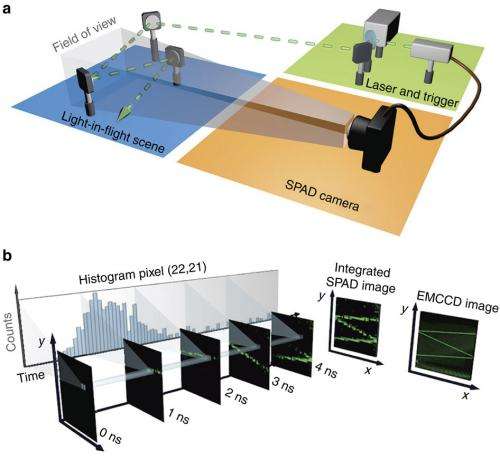January 29, 2015 report
Research group figures out a way to film a laser in normal air bouncing off mirrors (w/ Video)

(Phys.org)—A team of researchers working at the Institute of Photonics and Quantum Sciences, Heriot-Watt University, in Scotland has developed a method for filming a laser beam as it bounces back and forth between mirrors—in normal air. In their paper published in the journal Nature Communications, the team describes how they did it and share the video they created.
Laser beams, by their very nature, travel in a straight line from one point to the next, thus they are nearly impossible to see when traveling through normal air. The path of a single beam can be seen very easily, on the other hand if it happens to pass through smoke, or fog—this is because some of the light in the beam runs into particles that cause some photons to veer from their path and strike a viewers eyes. In this new effort, the researchers wanted to see a beam in normal air, which meant having to use special camera equipment.
Normal air has some particles in it, dust, etc.—photons that bounce from such particles can make it to a viewer's eyes, but they are so few and far between that they cannot be seen. To overcome that problem, the team used a single-photon avalanche diode (SPAD) detector with a very high temporal resolution. It takes a picture of a single photon (using a 32x32 pixel grid) and notes its location. The team pointed the SPAD at a beam as it was bounced off mirrors in a box, over and over (ten million times) during a ten minute period. That allowed for capturing all of the collisions and deflections that occurred during that time span. A computer then knitted all the photon hits together and animated the results, giving a video that very clearly shows the laser beam as it is emitted and then bounces off each of the mirrors in the box. The result is both eerie and very cool to watch.
Though it is not clear just yet if the technique will have any real applications (such as watching plasma develop as ions are heated), the team appears satisfied with their work noting that they were able to achieve their goal.
More information: Single-photon sensitive light-in-fight imaging, Nature Communications, 6, Article number: 6021 DOI: 10.1038/ncomms7021
Abstract
The ability to record images with extreme temporal resolution enables a diverse range of applications, such as fluorescence lifetime imaging, time-of-flight depth imaging and characterization of ultrafast processes. Recently, ultrafast imaging schemes have emerged, which require either long acquisition times or raster scanning and have a requirement for sufficient signal that can only be achieved when light is reflected off an object or diffused by a strongly scattering medium. Here we present a demonstration of the potential of single-photon detector arrays for visualization and rapid characterization of events evolving on picosecond time scales. The single-photon sensitivity, temporal resolution and full-field imaging capability enables the observation of light-in-flight in air, as well as the measurement of laser-induced plasma formation and dynamics in its natural environment. The extreme sensitivity and short acquisition times pave the way for real-time imaging of ultrafast processes or visualization and tracking of objects hidden from view.
Journal information: Nature Communications
© 2015 Phys.org




















